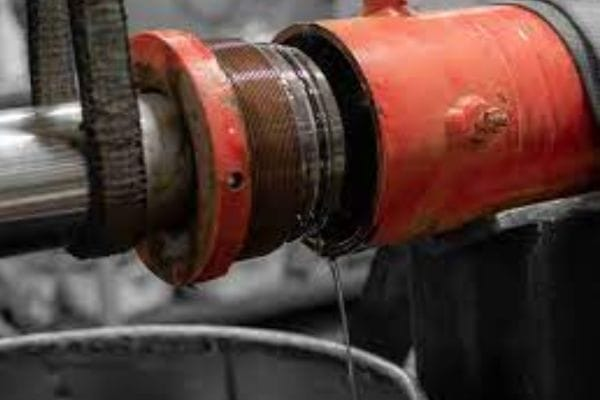Hydraulic cylinders, pivotal to snow plow for lifting, angling, and blade control, are central to operational efficiency. Leakage, a prevalent issue stemming from worn seals, fluid contamination, or extreme cold, can severely impair system functionality. Timely leak remediation is imperative—not only to restore plowing operations but also to uphold road safety, prolong equipment life, and forestall expensive future repairs.

Timely attention to hydraulic cylinder leaks in snow plow is crucial, as they frequently undermine performance and may lead to system collapse. Grasping the root causes of such leaks is vital for prevention and to maintain operational readiness during winter's peak demands.
Hydraulic cylinders' components, especially seals, undergo wear from continual usage, causing seal degradation and leaks over time. Seals, despite being durable, falter due to friction and environmental exposure, while piston rods, prone to scratches and bending, hasten seal damage. Heavy usage accelerates metal fatigue, potentially resulting in cracks and leaks. In high-demand scenarios like continuous snow plowing, vigilant inspection and timely replacement of worn parts are imperative to prevent failure.
Contamination of hydraulic fluid is a major leak source. Clean fluid preserves seal and component efficacy; however, dirt, metal shavings, and debris infiltration gradually erode seals through abrasion, forming micro-tears and leaks. This contaminated fluid also induces cylinder corrosion, with corrosive particles damaging metal surfaces, creating leaks via pits and irregularities. Thus, maintaining fluid purity is vital for seal integrity and leak prevention.

Proper maintenance is pivotal for hydraulic cylinder durability and reliability, yet inadequate practices often precipitate leaks. Misapplication of lubrication—be it the wrong lubricant or neglect—causes seal dehydration and cracking. Infrequent inspections overlook minor issues like seal cracks or piston rod bending, permitting their progression into leak sources. Hasty maintenance, such as incorrectly installing seals, creates vulnerabilities and gaps, facilitating fluid leaks under pressure.
1.Environmental Factors:Environmental conditions have a significant impact on snowplow hydraulic cylinders. Severe cold weather can cause seals to become brittle and crack, while moisture intrusion can accelerate internal corrosion. Corrosive materials such as road salt can accelerate corrosion of metal components and compromise the integrity of the cylinder.
2.Faulty Installation:Improper cylinder installation can lead to uneven seal pressure, accelerated wear, possible piston rod bending, and leaks due to stress points and poor quality components. Following the manufacturer's instructions and a meticulous installation process to ensure precise alignment and part quality are important steps to prevent leaks.
Hydraulic cylinder leaks can significantly impact the performance of your snow plow, but with the right knowledge and tools, many of these issues can be resolved through repair and replacement techniques.

Leaking hydraulic cylinders often result from worn seals. Seal replacement stands as a vital maintenance procedure to rejuvenate cylinder function and curb subsequent leaks.
Tools Required:
Seal kit specific to your hydraulic cylinder model
Wrenches and sockets
Seal pick or small flathead screwdriver
Pliers
Lubricant (appropriate for the seals)
Clean cloths
Safety Precautions:
Wear safety goggles and gloves to protect against hydraulic fluid exposure.
Ensure the hydraulic system is depressurized before starting the repair to avoid injury.
Step-by-Step Guide
1.Depressurize System: Ensure the hydraulic system is fully depressurized by activating the control valve to discharge any residual pressure.
2.Cylinder Removal: Detach the cylinder from the snow plow, unfastening mounting bolts. Support the cylinder securely throughout to avert damage or accidents.
3.Cylinder Disassembly: Gently unscrew the end cap or gland using wrenches. Extract the piston rod assembly from the cylinder barrel.
4.Seal Extraction: Carefully pry out the old seals using a seal pick or a small screwdriver. Note their orientation for accurate new seal fitting.
5.New Seal Installation: Apply suitable lubricant to the new seals for smooth insertion. Install them onto the piston and gland, confirming proper alignment without distortion.
6.Reassemble Cylinder: Reinsert the piston rod assembly into the cylinder, followed by reattaching and tightening the end cap or gland.
7.Cylinder Reinstallation: Secure the cylinder back onto the snow plow with mounting bolts, verifying all connections are tightened and correctly aligned.
8.Leak Inspection: Gradually restore system pressure and inspect for seal leaks. A leak-free system confirms successful seal replacement.
Damaged piston rods can lead to leaks and reduced performance. Depending on the severity of the damage, the rod may need to be repaired or completely replaced.
Step-by-Step Guide
1.Rod Examination: Check the piston rod for damage like bending, scratches, or corrosion. Light surface flaws can be rectified with emery cloth; severe damage necessitates rod replacement.
2.Minor Fixes: For minor imperfections, gently smoothen using emery cloth, avoiding excessive material removal that might impair fit or seal effectiveness.
3.Replace Damaged Rod: In cases of severe damage, disassemble the cylinder, replace the faulty rod with a new one matching the original specs, and reassemble.
4.Reassembly & Reinstallation: After cleaning and lubricating all parts, reinstall the cylinder onto the snow plow, applying correct torque to fastenings.
5.Performance Test: Reactivate the system and verify the cylinder's seamless operation and absence of leaks. A properly restored or replaced rod ensures cylinder functionality without fluid leakage.

Proper hydraulic fluid management is crucial for maintaining the performance and longevity of your hydraulic system. Regularly replacing the fluid helps prevent contamination and ensures the system operates smoothly.
Step-by-Step Guide
1.Drain Old Fluid: Position a drain pan beneath the reservoir, open the drain, and let the old fluid out. Ensure eco-friendly disposal.
2.System Flush: If heavily contaminated, flush the system using a flushing fluid or fresh hydraulic fluid.
3.Filter Replacement: Swap out the filter for a new one to prevent contaminant recurrence.
4.Refill with New Fluid: Gradually add new fluid, adhering to manufacturer guidelines, to the recommended level.
5.Bleed the System: Post-refill, cycle the controls to expel any introduced air, checking and topping up fluid as required.
Periodic checks and prompt maintenance aren't merely about averting expensive failures; they're about guaranteeing your snow plow's readiness during crucial times, thus protecting your investment and ensuring the safety of those depending on clear pathways. Should you find this guide beneficial, consider sharing it with others who might also find value in this knowledge.